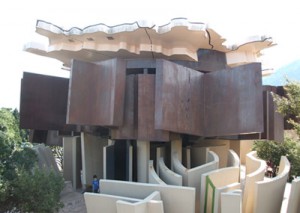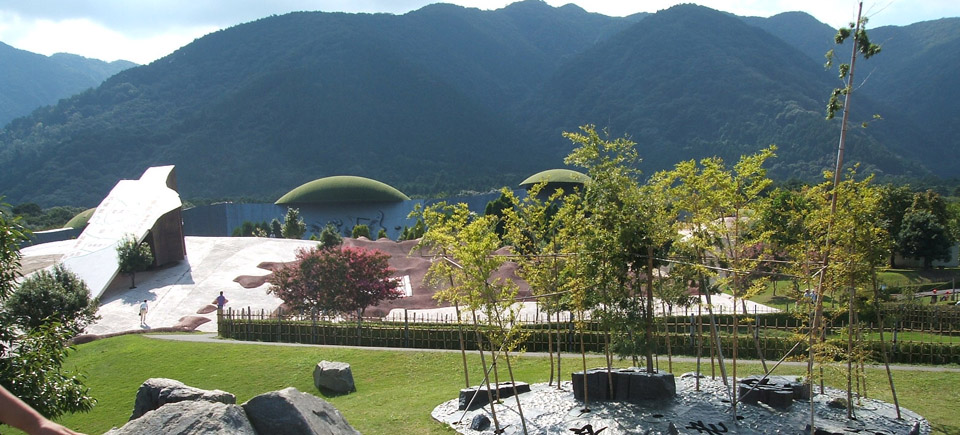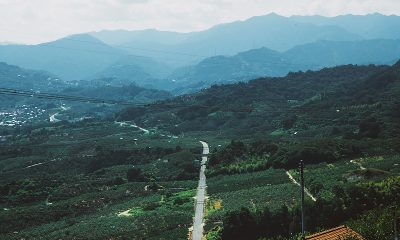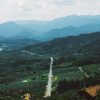Featured
The Site of Reversible Destiny
Seeking snow and hot springs in Gifu this winter? While you’re there, stop by the Site of Reversible Destiny and test your body and mind in this artistic playground.
 Cradled between the mountains of the Yōrō district, Gifu prefecture, the Site of Reversible Destiny resembles a dislocated patch of alien terrain, or perhaps even the set of a 1970’s sci-fi movie. Opened almost 20 years ago, the site is an ‘experience’ park, designed by artist Shusaku Arakawa and his wife Madeline Gins.
Cradled between the mountains of the Yōrō district, Gifu prefecture, the Site of Reversible Destiny resembles a dislocated patch of alien terrain, or perhaps even the set of a 1970’s sci-fi movie. Opened almost 20 years ago, the site is an ‘experience’ park, designed by artist Shusaku Arakawa and his wife Madeline Gins.
The peculiar name, Site of Reversible Destiny, is derived from Arakawa’s and Gins’ central artistic thesis: art and architecture have the potential to liberate the body from the bondage of habitual routine. By radically changing the relationship between architectural space and the body, the artists believe it is possible to transcend the mental and physical constraints of everyday life.
With 2000 square feet of textured landscape, forced perspectives, disjointed buildings and distorted interiors, the site is designed to throw the visitor, physically and meta-physically, off balance.
“Instead of being fearful of losing your balance, the idea is to look forward to the challenge, to something different,” says Arakawa. It is the aim of the Site of Reversible Destiny to “dislocate the mind and relocate the body”.
 The site is made up of two main areas: the main pavilion called the Critical Resemblance House, and a large concave basin called the Elliptical Field. A diverse range of vegetation also grows in the area, which not only softens the harsh conceptual contours of the installations, but also transforms the site’s overall appearance as the plants and trees change with the seasons.
The site is made up of two main areas: the main pavilion called the Critical Resemblance House, and a large concave basin called the Elliptical Field. A diverse range of vegetation also grows in the area, which not only softens the harsh conceptual contours of the installations, but also transforms the site’s overall appearance as the plants and trees change with the seasons.
After passing through the entrance, the first place to head for is the Reversible Destiny Office. Its sloped floors, walls of varying height, and a ceiling design that inversely reflects the floor design, immediately throws the visitor into Arakawa’s absurdist world. The office also houses drawings, computer graphics and art work by Arakawa, and screens a documentary charting the creation of the site – a good introduction for those unfamiliar with the work of the artists.
Between the office and the main pavilion stand two minor installations. The first is the Gate of Non-Dying – a bamboo enclave with the site’s Japanese name, Yoro tenmei hanten chi (養老 天命反転地), engraved on the copperplated ground.
The second is the Insect Mountain – a large pile of loose rocks that visitors are invited to clamber over in order to reach a water pump at its peak.
The main pavilion, the Critical Resemblance House, has a mazelike interior, carved into sections and roofed with a map of Gifu prefecture. Household furniture including tables, sofas, bath tubs, and beds are wedged between narrow, concrete corridors.
It is a clear critique of domestic life, a challenge to the preconceived notions of “home life” that have prevented the body and mind from reaching their true potential.
Linking the main pavilion to the Elliptical Field is the Exactitude Ridge, a network of trenches and walkways offering views of the Elliptical Field from varying perspectives. With names like “Road of Not Dying” and “Road of Not Disappearing”, it becomes clear that Arakawa and Gins’ intention to challenge the visitors’ sense of self is deadly serious.
The Elliptical Field is a collection of smaller installations that aim to disable the body’s normal functions. The bright yellow entrance to the Geographical Ghost, for example, leads to an interior so dark that it is necessary to use your hands and feet to feel your way along the corridor, at the end of which a map of Japan is illuminated on the ceiling by the daylight outside.
At first glance, the Elliptical Field looks like a chaotic collection of artifacts extracted from an extraterrestrial amusement park, but in fact the terrain was designed and shaped with mathematical precision. It is a sensory assault course of low, angular walls, undulating hills, mounds of soil, and steep slopes, with household furniture such as toilets and wash basins strewn around. It is a cross between the perceptual puzzles of an Escher painting and the Dadaist absurdity of Marcel Duchamp.
To navigate the area, visitors must crawl on all fours, twist their bodies, slide down slopes on their bottoms and leap over concrete obstacles. As with any other maze complex, the question “Where am I?” is constantly on the visitor’s mind. But in the Elliptical Field, where our bodies are contorted and senses constantly challenged, the question “Where am I?” slowly evolves into “What am I?” as the Site of Reversible Destiny beckons us to relocate our body in a dislocated realm.
The Site of Reversible Destiny
If you’re looking for a fun day out, it’s best to visit the Site of Reversible Destiny on Saturday or Sunday when the area is full of clambering kids and stumbling parents. If you are more interested in a deeper, metaphysical experience, it’s best to visit on a weekday.
• Open: 9am–5pm (entrance closes at 4pm)
• Closed: Mondays (except national holidays); closed the day following a national holiday
• Admission: Adults ¥710; high school students ¥510; junior high and elementary school students ¥300
• Access: Yoro Stn, 10-min walk. Maps will guide you to the site.
• Tel: 05-8432-4592
• yoro-park.com














